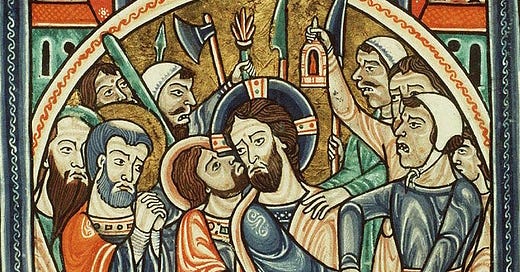Judas: Icon of the Merciful Depths of the Crucified Love of the God Who is Human
“Judas is still an elect and called apostle of Christ.”
Traditionally, the Wednesday of Holy Week recalls Judas’s betrayal of Jesus.
After stooping down like a slave and washing his disciples’s feet, Jesus breaks news of a betrayer. "Very truly, I tell you,” Jesus announces, "one of you will betray me.” Peter asks Jesus, "Lord, who is it?” And Jesus answers enigmatically, "It is the one to whom I give this piece of bread when I have dipped it in the dish." Jesus then dips the piece of bread, hands it over to Judas son of Simon Iscariot, and says to him, "Do quickly what you are going to do.”
John reports that immediately thereafter “Satan entered into Judas.”
Two or three hours later, Judas leads a torch-carrying mob of religious officials to the garden of Gethsemane on the Mount of Olives where Jesus is praying. The chief priests and the Pharisees have been hunting Jesus for over a week. They first plotted to kill him after Jesus raised Lazarus from the grave.
At the Fall, in the garden, God went searching for Adam, whose sin had caused him to hide in shame. “Adam, where are you?” the Lord had asked. On the eve of redemption, sinful Adam comes searching for God who is hiding in plain sight, naked and unashamed, in a homeless carpenter. “We’re looking for Jesus of Nazareth,” we say. After he walked on water, when Jesus taught in the Temple and upset more than tables and cash registers, John reports that “No one was able to lay a hand on Jesus because his hour had not yet come.”
But when his hour does come, when the betrayal of Judas leads these begrudgers through the darkness of night to the light of the world, Jesus voluntarily and deliberately gives himself up. The one who has preached peace does not resort to violence in order to resist them.
He identifies himself.
No— he reveals himself.
“We’re looking for Jesus of Nazareth.”
Jesus responds with his final I AM saying. And this last self-attestation is as stripped down and bare as he soon will be upon the cross. “I AM,” announces. And immediately, John writes, Judas and the lynch mob stumble backwards and fall to the ground. They understand. One is not bold in an encounter with God.
“I AM.”
Ego eimi.
As Fleming Rutledge says:
”This is the climax of the I AM sayings, and, really, it cannot be construed as anything other than a deliberate appropriation by Jesus of the name given by God to Moses from the burning bush. Therefore, precisely at the moment when his passion begins, Jesus unequivocally identifies himself as nothing less than the living presence of the God of Abraham, Isaac, and Jacob, the creator of the universe, the Lord who is and who was and who is to come.”
Martin Luther compressed the mystery of this culminating I AM saying with the Latin phrase Finitum capax infiniti:
“The finite is capable of containing the infinite.”
This messiah contains more than multitudes. In the end, what holds the Bible together are neither propositions nor pictures but a person. Scripture’s constellation of recurring images (garden, tree, water, blood, bread, light, vine and door) all terminate in a single, singular icon— the God who is human.
The only instance where Jesus says or does something in John’s Gospel that does not end with someone believing in Jesus is in Gethsemane standing before Judas and the thugs about to bind him.
After stumbling backwards and falling to the ground, Judas runs away.
He returns the thirty pieces of silver to the ones who bought him. And then he enters a passion of his own in a place the priests later named Akeldama, Field of Blood [Money].
Where Jesus gives up his life upon a tree, Judas takes his life upon a tree.
Where Jesus surrenders his life believing the Father will vindicate him, Judas forsakes his life upon a tree believing there was no longer any hope for him.
Keep reading with a 7-day free trial
Subscribe to Tamed Cynic to keep reading this post and get 7 days of free access to the full post archives.




